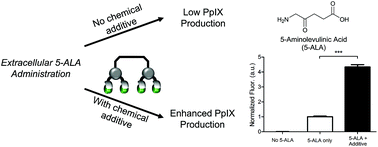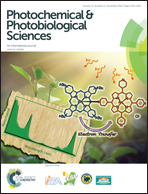Small molecule additive enhances cell uptake of 5-aminolevulinic acid and conversion to protoporphyrin IX
Abstract
Administration of exogenous 5-aminolevulinic acid (5-ALA) to cancerous tissue leads to intracellular production of photoactive protoporphyrin IX, a biosynthetic process that enables photodynamic therapy and fluorescence-guided surgery of cancer. Cell uptake of 5-ALA is limited by its polar structure and there is a need for non-toxic chemical additives that can enhance its cell permeation. Two zinc-bis(dipicolylamine) (ZnBDPA) compounds were evaluated for their ability to promote uptake of 5-ALA into Chinese Hamster Ovary (CHO-K1) cells and produce protoporphyrin IX. One of the ZnBDPA compounds was found to be quite effective, and a systematic comparison of cells incubated with 5-ALA (100 μM) for 6 hours showed that the presence of this ZnBDPA compound (10 μM) produced 3-fold more protoporphyrin IX than cells treated with 5-ALA alone. The results of mechanistic studies suggest that the ZnBDPA compound does not interact strongly with the 5-ALA. Rather, the additive is membrane active and transiently disrupts the cell membrane, permitting 5-ALA permeation. The membrane disruption is not severe enough to induce cell toxicity or allow passage of larger macromolecules like plasmid DNA.


 Please wait while we load your content...
Please wait while we load your content...